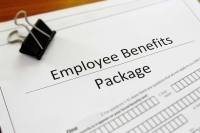
Health & Financial Wellness Articles
More employees than ever before are looking for employers who take their financial wellness and health into account. How can you help your employees stay healthy and manage their financial futures?
It’s never too early to start preparing for retirement. The planning process can get quite overwhelming and it requires discipline, time and effort. Taking care of your financial wellness today will ensure that your retirement goals are manageable while you get to maintain the lifestyle you hope to enjoy as you age.
You may be in good physical health. But how’s your financial wellness? It's an increasingly important answer to know for baby boomers rocketing toward retirement (almost 10,000 hit age 65 every day). While many have planned and saved and are eager for their next chapters, others are headed for serious financial anxiety.
Financial wellness: It’s an HR buzzword. But with a number of players involved — from the C-suite to benefits managers to brokers and employees — there often is confusion regarding the best kind of program, the best way to implement it and how to get employees engaged. That’s leading to a lot of discussion — but few concrete solutions.
When it comes to well-being in the workplace, which extends to one’s personal life, there are two key points to consider. One is an employee’s health. The other point is an employee’s financial health. When the two are put together, the result is a useful health and financial wellness program and a better-run company.
Human resources departments across all industries have tried to find or build effective employee benefits communications systems to help their workers navigate the confusing and exhausting world of insurance coverage, retirement and other common healthcare and voluntary benefits options. The goal of this investment and effort is to give workers the information they need to make the right decisions for themselves without spending excess time, money and brainpower on benefits enrollment.
From healthcare to retirement, employers stepped up their game as some perks rose in popularity while others faded. For the past year, editors at Employee Benefit News have compiled lists aiding employers in strategizing their benefit offerings. Based on page views, below are the top lists of 2018.
The good news is, U.S. consumers may be taking wellness more seriously. The bad news: Advisors might be competing for consumers’ attention with people who have a strong opinion about whether spaghetti is suitable for people who need to lose weight.
Every employee values workplace perks but does its importance outweigh being paid more?
Have you ever noticed how Amazon sends you an email for something, you click, and then 10 minutes later you’re looking for one more item—just so you can get free shipping? What the heck just happened?! Amazon and companies like it have huge teams of marketing experts who know how to drive your behavior and get you to make that extra purchase. We apply these same techniques to drive employee behaviors, and you can, too.
Open Enrollment is in full swing and if you’re a small business owner with the ability to offer employees benefits and compensation packages, you’re probably already hearing all about it. Your employees are making the best decisions they can right now to make sure they’re enrolled in health insurance plans that make sense for them. Even as Open Enrollment progresses, there are still several considerations small business owners and leaders need to have.
Workplace wellness programs that offer employees a financial carrot for undergoing health screenings, sticking to exercise regimens or improving their cholesterol levels have long been controversial.
Health and financial wellness plans have evolved quickly in the last few years, offering employees newer and better options to relieve some of the money-related stress they experience and plan better for retirement. The next step in this evolution is access to personalized financial wellness plans for each employee. Why is this so important and why are personal financial advisors in vogue now?
The top 10 providers of Health Savings Accounts are making ground in improving the transparency, pricing, and structure of their products but still have room to grow as the market does, according to new analysis from Morningstar.
With human resources managers across the country working to finalize their 2019 benefits packages this month, many are asking themselves: How can we add more value for our talent and help the company grow?
Small employers historically have faced a big retirement challenge: Though most want to offer retirement benefits to their employees, they’re discouraged by the cost and complexity of running their own plans. But there may be relief on the horizon: The Department of Labor last month released a proposed regulation that would allow small businesses to band together to offer employees defined contribution plans.
Cisco is getting a lot more family-friendly in 2019. The tech giant is rolling out egg storage reimbursement, surrogacy reimbursement and genetic testing benefits for its 38,000 U.S. employees — following the lead of other employers that are ramping up family-oriented perks to attract and retain talent.
Transamerica announced today the availability of "Impact of Employee Health on Business Success," a research paper that provides analysis and recommendations for creating effective workplace wellness programs. The white paper alerts employers to risk factors and mitigation of chronic health conditions.
The conversation around financial wellness isn’t new, but it’s definitely ramping up. According to a recent survey by Prudential, the percentage of employers offering financial wellness programs rose to 83%, up from just 20% in the survey two years ago.
It seems pretty obvious that health and financial wellness benefits ought to be very popular and should enjoy high levels of employee engagement. Some are popular and do enjoy high levels of engagement, but many don't. To figure out what doesn't work is easiest if we ask which benefits get the most engagement and work backwards from there.
Our daily roundup of retirement news your clients may be thinking about.






















